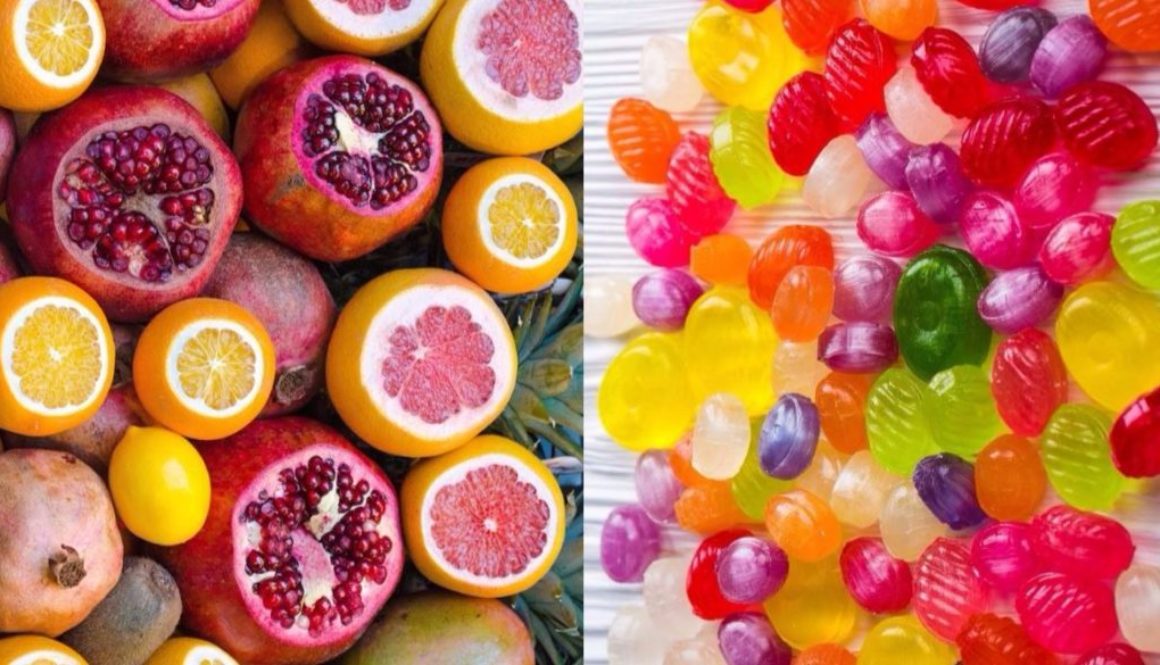How do you go to the store without buying candy?

Can’t there be a ban on candy in our stores? I know.. “Adult people making decisions on their own. What kind of communistic society would we have if the people in charge started dictating what we can or can’t eat” This blog is not an attempt at changing legislation nor is my aim to guilt trip all us consumers going against our better judgement and buying sugar filled products now and then.
I just wanted to vent my frustration over having to deal with the sugar issue so often. Commercials and the availability of candy makes my parenting life a bit more challenging than I’d like it to be. Maybe some of our strategies for fighting the sugar addiction will work for you, maybe you’ve got some tricks for us?
Taking my hungry children, or a hungry me, to the store = bad idea
A number of years ago the following scenario was a common one. Walking into the supermarket on the way home from work. I’ve picked up my two girls from daycare, they’re about 4 and 6 years old and as we walk in my youngest asks me “Mommy can we have some ice cream today?” I know they’re tired, I know they’re hungry and the easiest answer would be to say yes. Not only would I have an easier time getting home, I would instantly be the hero of the day in my girl’s eyes.
I can’t say at what ratio I’ve managed to stay true to my conviction and resisted the urge to cave into their sugar monsters. To be honest I believe my own sugar monster/cravings has directed my actions more often than theirs.
I’ve tried a number of strategies for minimizing the nagging and resisting buying things I think are bad for us in a long term perspective. The most effective one has been to help them become aware of their feelings and how they are affected by our surroundings.
The desire for sugar could be an evolutionary super power
In terms of an evolutionary viewpoint a lot has happened very quickly in the way we live as humans. Food with a high calorie count based on carbohydrates has never been more accessible than in the last decades.
Some argue that the human DNA, and our triggers to different kinds of food, hasn’t had the time to adapt to the availability of the modern time. If we go back in time our human ancestors were moving with the seasons harvesting the earth for food. Within that background there are clues to our eating triggers in terms of sugar. Eric Edmeades, entrepreneur/speaker/author, has described one of the triggers in a, to me, logical and easily relatable story.
Get more while you can! – Winter’s coming!
“Imagine that you’re a human ancestor about 100 000 years ago. You’re living in accordance to nature and the seasonal harvests of the earth. To be able to survive the dry season, when food is scarce, you need to store energy during times when energy is abundant. The season before a dry season would be equivalent to “autumn” meaning the period when fruit and berries are ripe. When a human ate something with typically high sugar intake it would be a signal to the body that “winter’s coming”. The human DNA would then “help” to prepare in two ways;
- Switch the metabolism rate down
- Signal to the human to “get as much as you can while you can!”
Imagine finding a fruit tree and eating of that tasty fruit. When you’re full you begin to walk away but all of a sudden you get this enormous urge/desire/need to go get some more.”
I believe this is part of why some people, myself included, have a really tough time to “just eat one” cookie. The body responds by urging you to get more. If I don’t take that first cookie I’m usually fine. I’m not saying this is the single answer to sugar addiction but what if this could be a part of the explanation?
Help your child understand the craving
One way to create awareness in a child is to tell them the story about the “sugar monster”. Pay attention to how the child reacts, some doesn’t like the idea of having a “monster” inside. If you know that your child is sensitive or if you notice that the story is a little upsetting then just adjust into maybe a… “sugar rascal” 🙂
The Sugar monster
“Inside of you there is a little monster that loves to eat sugary things. It’s like a little sleeping creature that wakes up and feeds when it’s given candy, cake and fuzzy drinks. If there is just a little sugar the monster won’t get enough to fully wake up. But if you give it too much then the monster will wake up completely and start making demands! The more you feed it the larger and louder and more rude the monster gets. However if you refuse to give the monster any sugary food for a day or so it will shrink. Soon you almost won’t hear it at all and then it will snuggle up and just go back to sleep again. Sugar monsters really like to sleep and be rocked by you when you walk and run around playing. “
The story enable you to talk about sugar in a new way. Now you can relate to it when you want to keep the sugar levels down.
Tips for making it through the story without a fight
The sugar monster story has helped my girls to relate to their cravings in a way that empower them. On the way to the store I can ask them about the status of their sugar monsters – “Are they asleep or awake and behaving up?” This way we can manage the awareness about the “need” before we go in.
Here are some other tips I’ve tried.
- Bring a banana or an apple that they can nibble on while you’re shopping. This will distract their attention as well as keeping the worst hunger in check
- If you have the possibility then sit down for a couple of minutes before entering the store. Connect to your child and talk for a little while. Tell her/him that you’re about to go shopping and that this time you won’t buy anything sugary. Ask her/him not to nag you about it.
- Explain about store marketing plans for candy/sugars
This is a great way to create awareness and the ability as well as desire to resist. Ask them if they know why there is always so much candy close to the checkout line. Explain that it’s well thought out and done on purpose. The checkout line is where all parents have to go and stand close to so that’s where the children will be able to see and want candy. - Get them involved in the grocery shopping by asking them to find things from the shopping list.
If you have ideas or strategies that have worked for you I’d love to hear from you in the comments.

